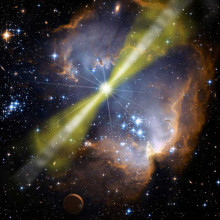The Trillion Frame Per Second Camera
In this NewsFlash, we hear how the reality of Finding Nemo might be Not Finding Nemo, as a new survey looks at just how endangered the species in Disney's film are, and we discover the trillion frame per second camera - fast enough to catch a pulse of light as it moves across a scene...
In this episode

00:23 - Not finding Nemo
Not finding Nemo
Not finding nemo is in fact more likely scenario, since it's been revealed that one in six species featured in the movie Finding Nemo are at risk of disappearing from the oceans, due mainly to overfishing.
 A research team from Simon Fraser University in Canada and the World Conservation Union (IUCN), examined the extinction risk facing over 1,500 marine species, including all the species the 16 families of marine animals that feature in Finding Nemo. They include hammerhead sharks, sea turtles, pelicans, pufferfish, eagle rays, and seahorses.
A research team from Simon Fraser University in Canada and the World Conservation Union (IUCN), examined the extinction risk facing over 1,500 marine species, including all the species the 16 families of marine animals that feature in Finding Nemo. They include hammerhead sharks, sea turtles, pelicans, pufferfish, eagle rays, and seahorses.
Information came from the IUCN's Redlist Assessments, which rank extinction risk ranging from Critically Endangered, through Endangered, Vulnerable, and Near Threatened. These categories are all based on a detailed set of standards against which the size of populations and changes they've undergone are gauged. If there's not enough information on those factors, then the Data Deficient label is assigned.
12-35% of the species examined are considered to be threatened with extinction (including Critically Endangered, Endangered, and Vulnerable rankings).
The point of this study isn't to see if Hollywood has anything to say about extinction in the sea, but to assess how well famous, charismatic species are getting on both in terms of their current status and our efforts to protect them. Because if we can't figure out conservation for glamorous animals like sharks, turtles, and lovely coral reef fish, what hope is there for lesser-known species that don't make it onto the silver screen and few people have heard of?The research team also looked at how well these endangered movie star species are being protected by international agreements and found a general lack of conservation measures in place. An exception are the seahorses, which are some of the few bony fish whose international trade is strictly controlled and monitored by the Convention on International Trade in Endangered Species (CITES).
The study also highlights the lack of science focused on these marine species with still far more attention given to habitats and species on land compared to beneath the sea.
It's not all doom and gloom. Public awareness doesn't always come hand in hand with conservation - after Finding Nemo was released, there was a surge in sales of clown fish for aquariums, and in kids flushing their nemos down the toilet. But we are seeing increased interest in both research and protection for marine species - good examples are the recent bans on shark finning and shark fin trade in various countries and cities around the world.

05:14 - All I Want for Christmas is a Gamma Ray Burst
All I Want for Christmas is a Gamma Ray Burst
This is something of a Christmas firework leftover from last year. A gamma-ray burst was observed at about dinner time in the UK on Christmas day last year. A gamma-ray burst is a burst of radiation similar to what you would find in a nuclear reactor, but thankfully very much weaker, coming out of the night sky. These are normally very short events. Many of them last less than a couple of seconds so they're very difficult to observe, but even longer lasting events are typically over within over a couple of minutes. This one, however, was really quite a surprise because the gamma-ray particles carried on coming for about half an hour and some could even be seen after about 45 minutes!

' alt='Artists illustration of a gamma ray burst' >It's quite a challenge to explain what this could've been; an event so energetic it produced these high energy gamma-rays for such a long prolonged period. We have various ideas about what causes most conventional gamma-ray bursts. We think the short ones are probably caused by neutron stars colliding with one another, and the tremendous release of gravitational energy as those two stars combine and form a black hole. That energy is released as gamma-rays over a period of about 2 seconds as neutron stars are so dense they can combine very quickly. We think the longer bursts are caused by the supernovae at the end of the lives of very massive stars. But even they will only last for a couple of minutes. So how could they possibly prolong this process to last for half an hour?
Publishing in the journal Nature earlier this month, there were two papers presenting two very different theories as to what this could have been. One of the theories is that this was a neutron star colliding with a massive star, just as it was about to go supernova, quite a realistic scenario because as a star is about to go supernova, it will expand; If there is a neutron star in a close orbit around it, it will attract and engulf that neutron star. This could lead to the two types of gamma-ray burst happening back to back, possibly leading to a prolonged emission of gamma-rays.
The other model is a complete contrast to that. It suggests this was quite a small event, relatively nearby in our own galaxy. Perhaps a rocky asteroid came to close to the neutron star it orbited, and became broken up by the tidal gravitational forces around the neutron star. These pieces could then fall in, one by one, over the period of about half an hour, leading to lots of very weak gamma-ray bursts. On Earth, we may see this as a continuous spread of gamma-rays.
Both of these theories actually fit the observations pretty well, but this illustrates that there's probably not any one mechanism which is responsible for all gamma-ray bursts. These interesting events are probably caused by a huge range of phenomena, and just happen to look quite similar when we observe them.

08:48 - Trillion frames per second
Trillion frames per second
You may have tried slowing down a film you made of a mobile phone, eventually the playback become jerkey, because the camera only records about 15 or 30 images or frames a second, and there is no information about what is going on between the frames. Better cameras can takes more frames per second, Kitchen Science has various videos taken with a camera that can take up to 1000 frames per second, and others can take hundreds of thousands of frames per second. But Professor Ramesh Raskar at the media lab have created a camera that can produce a film at a trillion frames per second!
They have done it using a streak camera, which only looks at one line of the image at a time, which is projected onto a screen. This converts the light signal into a signal of free electrons. These are accelerated along a vacuum tube towards a detector at the other end of the tube. The beam of electrons is scanned across the detector very quickly, so as time passes they hit different parts of the sensor, and you end up with a 2D image which consists of how theline changes with time.
The camera isn't quite true 1 trillion frames per second as to build a proper video, you have to repeat the process for each line in the image, which limits its use, to things which exactly repeat again and again. Despite this the results are still increadable. They have illuminated various scenes using an extremely short pulse of light, and in their videos you can actually see the pulse of light moving at 300 000 km/s moving across a scene about 300mm across.
This is very pretty, but they have some more useful applications in mind, if they shine a very short pulse of light a scene where you can see an object and its reflection you see the reflection slightly after you see the object itself, which suddenly becomes very useful if you wanted to understand a scene which includes reflections of reflections, like you would see in you looked into a translucent object like many engineering devices or human flesh. So it maybe possible to reconstruct what is happening deep within your body using normal visible light.









Comments
Add a comment